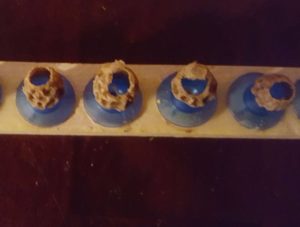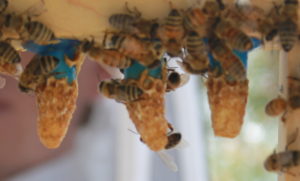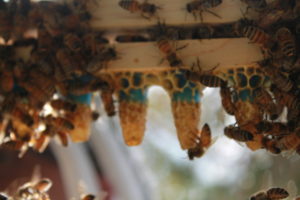June 4th – Splitting to Nucs
This past Tuesday we ran into some problems with our first graft, we had an early hatch in the queen cell finisher and lost half of our queen cells. When a virgin queen hatches she goes around the hives and tears down all the other existing cells to claim the hive for herself. Usually there is only one queen per colony, and this is just how nature works, timing is everything when making queens.
So on Wednesday I started again! Many folk get discouraged rather than learning from experiences and pushing past errors and obstacles. If you want to be successful in livestock management you have to accept failures and try again. You don’t become successful by feeling sorry for yourself and not pushing ahead.
Lucky for me, I am afforded a flexible schedule at work and could take Friday off with relatively short notice. One of my beekeeping neighbors, about a 45 minute drive away had 30 cells he made available to me. I picked them up and put in 12 hours of bee work during the day. It was sweltering…. 36C was the high for the day, much warmer under a bee suit!
My splitting technique uses what folks call double nuc colonies, two 5 frame nucs in a regular deep box, I set them up to have opposite facing entrances so the queens don’t accidentally end up in the same hive after mating flights.

A regular deep brood box, split by a 1/4 inch divider will house to production nucs for the remainder of the season and through winter.
I run these double nucs straight through the flow and pull 60-100 lbs of honey off them. They also winter in this setup, sharing heat, improves survival, also if one side fails the other side just becomes a strong nuc.
when splitting I like to use 2 frames of bees and brood and one frame of honey/nectar per new colony. The queen cell is pressed into one of the brood frames to hatch out in the new hive.
The new hive is then covered with 2 separate inner covers, to keep the colonies from mixing while the queens are bred and the hive builds up in strength. If feed frames are in short supply I have feeder holes drilled in them and a removable plastic plug to use feeder pails.
Within the next 15 days these hives should all have a mated queen and be ready to produce a small honey crop for me to pay their own way.
I have used this technique successfully over the past 4 seasons, and am somewhat proud to be able to say, the 5 original hives I purchased my first year, are the only colonies I have ever purchased. We have split using the double nuc system and this year should have between 125-150 colonies if things go smoothly going forward… This is how you keep bees successfully, make bees and buy equipment, bees can die overnight and will be a complete investment loss if purchased, your equipment will always hold value.
Lets go back to when I said I started again on Wednesday, Several things I changed this time around, I primed the cells with a small amount of water to keep the fresh brood moist and help it float off the grafting pen easier. I also made my cell builder much stronger and congested this time. I took a strong double deep hive and shook all the bees down into a single box, then I shook another 5 frames of nurse bees into the hive, from another strong hive in my yard. You want the bees to plow all of their energy into making excellent queens, the more nurse bees are in the hive, the more the cells will be cared for.
I had an 80% graft acceptance rate on this run, and they all look amazing! Here are the cells as a result of the changes I made, are they not the most beautiful things you have ever seen?!?
Lets see if I can get the timing right this time!







Leave a Comment